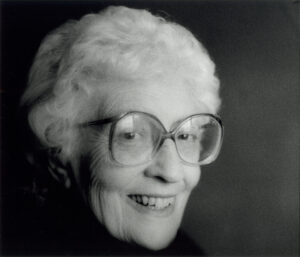
“We have to dare to be ourselves, however frightening or strange that self may prove to be.” –May Sarton
Born Eleanore Marie Sarton on May 3, 1912, in Belgium to a Belgian father and English mother, May Sarton was an important and prolific American author of poetry, literature, and journals during her 66-year writing career. While Sarton was still a toddler, her parents fled German-occupied Belgium following the 1914 assassination of Archduke Ferdinand, and the family lived briefly in England before settling in Boston, Massachusetts. After graduating from Cambridge High and the Latin School in 1929, she briefly took an apprenticeship with the Civic Repertory Theatre in New York. Her interest in the stage, though, was eclipsed by her interest in writing poetry. At the age of seventeen, she published a series of her sonnets, many of which were later published in her first book, Encounter in April (1937). At the age of 19, Sarton moved to Paris for a year—a time that would prove influential in her writing. It was in Paris that Sarton met and moved in the same circles with such luminaries as Virginia Woolf, husband and wife duo Julian and Juliette Huxley, and Elizabeth Bowen, among others. She began an affair with Julian Huxley whom she later abandoned for his spouse, Juliette. In 1999, Dear Juliette: Letters of May Sarton to Juliette Huxley, was published, containing a collection of letters between the two women.

Sarton’s writing has often been described as beautifully expressive, emotional, thought-provoking, and honest. She was a prolific writer and contributed 19 novels, 17 books of poetry, several journals, two children’s books, and a play. Many of her works touch upon lesbianism, making Sarton a pioneer in American literature by portraying lesbian love in a non-judgmental and human way at a time that sexual minorities faced incredible discrimination in this country. Yet, she didn’t see herself as a lesbian writer, preferring to concentrate on what is universal in love and relationships. When she published her novel Mrs. Stevens Hears the Mermaids Singing (1965), she said that it took courage “to write a novel about a woman homosexual who is not a sex maniac, a drunkard, a drug-taker, or in any way repulsive, to portray a homosexual who is neither pitiable nor disgusting, without sentimentality.” She also frequently confronted sexuality, racism, and feminism in her writing, but the themes she touched upon were always universal: love, friendship, and relationships.

Mrs. Stevens Hears the Mermaids Singing. New York: W. W. Norton, [1965]. 1st edition.
https://lccn.loc.gov/65018016
|
|
|
Sarton’s journals and memoirs are among her most engaging works, and in them, she recounts her own challenges with solitude, loneliness, illness, the death of friends, and the challenges of aging. In her Journal of a Solitude, Sarton, 60 years old and suffering depression, states that to survive, we must “imitate the trees. Learn to lose in order to recover, and remember that nothing stays the same for long, not even pain, psychic pain. Sit it out. Let it all pass. Let it go.” Sarton suffered a debilitating stroke later in life, yet she continued writing until her death from breast cancer in 1995. Before her death, Sarton expressed a desire that her work would be seen by readers as “a whole, the communication of a vision of life that is unsentimental, humorous, passionate, and, in the end, timeless.”
|
|
|
The Rare Book and Special Collections Division holds a number of Sarton’s first editions in the Rare Book and Gene Berry and Jeffrey Campbell Collections. In 2015, the division purchased a series of May Sarton poetry broadsides through the LC-GLOBE Maphon Ashmon Rare Book Fund. In 2016, the division received three gift portrait photographs of Sarton by the photographer Stathis Orphanos, who traveled to her Maine home with Gyula Visnyei, ca 1993.
SOURCES
Peters, Margot. May Sarton : A Biography. New York: Knopf: Distributed by Random House, 1997. https://lccn.loc.gov/96025557
Wikipedia – https://en.wikipedia.org/wiki/May_Sarton
RESOURCES
Julian and Juliette Huxley papers, 1899-1988, MS 512, Woodson Research Center, Fondren Library, Rice University. https://archives.library.rice.edu/repositories/2/resources/438
Language of the Land: Journeys Into Literary America: The Northeast. Scenery between Gorham and Shelburne New Hampshire. May Sarton, “All Day I Was With Trees.” https://www.loc.gov/exhibits/land/landnort.html
May Sarton Papers, 1939-1988, MC 366, Milne Special Collections and Archives, University of New Hampshire Library, Durham, NH, USA. https://library.unh.edu/find/archives/collections/may-sarton-papers-1939-1988
The May Sarton Papers in the Henry W. and Albert A. Berg Collection of English and American Literature, The New York Public Library. https://archives.nypl.org/brg/19101#descriptive_identity
May Sarton and Romulus Linney reading from their work in the Coolidge Auditorium at the Library of Congress, Apr. 23, 1979.
Click here to subscribe to Bibliomania and never miss a post!




